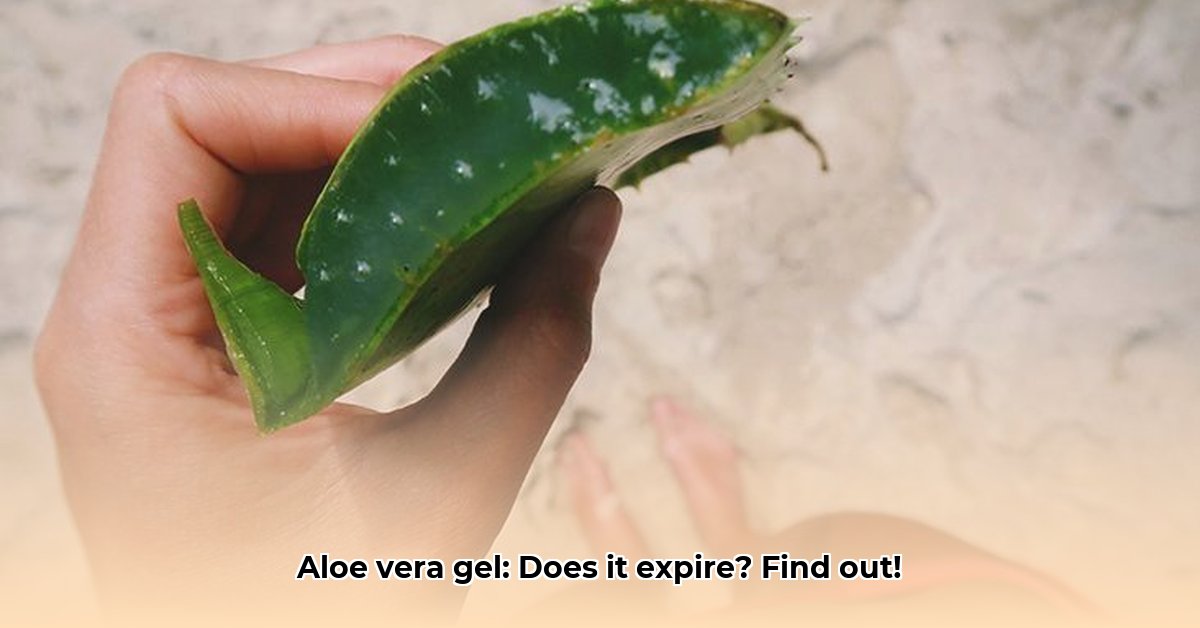Ever wonder if that aloe vera gel in your bathroom cabinet is still good? It’s a common question, and the answer isn’t always straightforward. This guide will give you the lowdown on how long aloe vera gel lasts, whether it’s the fresh stuff or the processed kind you buy at the store. We’ll cover everything from how to store it properly to spotting signs it’s gone bad. Whether you’re a skincare enthusiast or just want to make sure you’re not wasting money, this guide will help you get the most out of your aloe vera. Just like other natural products, knowing how long things last is key; for example, learn more about product expiration with this helpful guide on [diaper shelf life](https://chaztin.com/do-diapers-go-bad/).
Does Aloe Vera Gel Go Bad? Decoding Expiration and Spoilage
Let’s talk about aloe vera gel – that soothing substance we all love for sunburns, minor cuts, and even as a hair conditioner. But does it have an expiration date? The simple answer is yes, but it’s more nuanced than that. The lifespan of your aloe depends on several key factors: Is it fresh from the plant, or store-bought? And how are you storing it? Understanding these differences is crucial to maximizing its benefits and avoiding potential skin irritations from using expired product.
Fresh vs. Store-Bought Aloe Vera: Understanding the Lifespan Difference
Imagine freshly squeezed orange juice – it needs to go in the fridge ASAP, right? Raw aloe vera gel is similar. It’s packed with beneficial compounds, but it also lacks preservatives, making it susceptible to bacteria and other microorganisms. Left out at room temperature, it’ll likely spoil within a few days, turning cloudy and smelling unpleasant. Even in the refrigerator, it’s probably only good for a week or two at most. Freezing it might extend its life a bit, but keep in mind that refrigerating or freezing raw aloe changes its texture and may affect its potency.
Store-bought aloe vera gel is a different story. Most commercial aloe gels contain preservatives that help them last much longer – maybe a few months, or even a couple of years, depending on the brand and how it was processed. These preservatives combat bacteria and slow down the breakdown of the gel. However, even these preserved gels aren’t immortal! Always check the expiration date on the packaging.
The Telltale Signs: Recognizing Aloe Vera Gel Spoilage Signals
Whether you’re using fresh or store-bought aloe, there are warning signs that it’s time to say goodbye. Your senses are your best allies here:
- Color Changes: If your once clear or slightly translucent gel starts looking cloudy, darker, or develops a brownish hue, that’s a red flag.
- Texture Changes: Has it thickened, thinned, developed lumps, become overly slimy, or separated? These textural shifts signal that something is amiss.
- Smell Test: Does it have a sour, musty, fermented, or just plain “off” odor? Trust your nose! An unfavorable smell usually indicates the aloe has gone bad.
- Mold Alert: This is an absolute no-go. Any visible mold of any kind – discard it immediately. No exceptions! Mold spores can cause skin irritation and infections.
Keeping Your Aloe Fresh: Effective Storage Strategies for Longevity
Proper storage is crucial for maximizing the life of your aloe. Here’s a handy guide:
For Freshly Harvested Aloe:
- Refrigerate Immediately: Place it into a clean, airtight container in the refrigerator as soon as possible after harvesting.
- Use it Quickly: Aim to use it within one week for optimal quality and to maximize its beneficial properties.
- Consider Freezing: Want to keep it longer? Freezing can help extend its lifespan to about two weeks, but remember it might change the texture, making it less smooth upon thawing. Consider blending it before freezing to minimize texture changes.
For Store-Bought Aloe:
- Read the Label: Always check the manufacturer’s instructions and pay close attention to the expiration date printed on the packaging.
- Follow Storage Guidelines: This typically involves storing in a cool, dark, and dry place, away from direct sunlight and heat sources. Sometimes, refrigeration might be recommended – check the label!
- First In, First Out (FIFO): If you have multiple bottles, use the older ones first to avoid waste and ensure you’re using the freshest product possible.
- Tighten the Lid: Ensure the lid is tightly sealed after each use to prevent air exposure, which can accelerate spoilage.
Aloe Vera Gel Shelf Life: A Quick Reference Table
Here’s a handy table summarizing aloe shelf life:
| Type of Aloe Vera Gel | Storage Conditions | Approximate Shelf Life | Notes |
|---|---|---|---|
| Freshly Harvested | Refrigerator | 1 week | May last a bit longer if harvested and stored under sterile conditions. Adding Vitamin C can also extend shelf life. |
| Freshly Harvested | Freezer | Up to 2 weeks | Texture and potency may be affected upon thawing. Best used for topical applications after freezing. |
| Store-Bought | As directed on packaging | Varies (check label) | Always follow the manufacturer’s instructions. Typically lasts for several months to a couple of years if stored properly. Check for an expiration date on the bottle. |
The Bottom Line: Does Aloe Vera Gel Go Bad? Yes, But…Understanding Aloe’s Limitations
So, does aloe vera gel eventually go bad? Absolutely. However, understanding the factors affecting its shelf life and following simple storage guidelines can help you maximize its usability and ensure you’re using a safe, effective product. When in doubt, it’s always better to err on the side of caution. If it looks, smells, or feels off, it’s best to discard it. Your skin will thank you! Remember, ongoing research continues to refine our understanding of aloe vera’s properties and preservation. Stay updated on the latest findings to make informed choices.
How to Extend Aloe Vera Gel Shelf Life Using Natural Preservatives
Key Takeaways:
- Aloe vera gel’s lifespan varies greatly depending on processing, storage, and preservation methods.
- Refrigeration significantly extends shelf life, typically to 1-2 weeks or even a month with added preservatives.
- Freezing aloe vera gel in ice cube trays can maintain its quality for 6-12 months, though potency might slightly decrease.
- Unopened, commercially produced aloe vera gel with added preservatives can last up to two years if stored in optimal conditions.
- Signs of spoilage include changes in color, odor, and texture. Mold indicates immediate disposal.
- How to extend aloe vera gel shelf life using natural preservatives involves methods like incorporating honey, lemon juice, or vitamin E oil.
Understanding Aloe Vera Gel Spoilage: Key Factors
Ever wondered how long that aloe vera gel in your fridge will last? The answer isn’t straightforward. Fresh, unprocessed gel spoils quickly due to its high water content and lack of preservatives. Processed gels, on the other hand, often contain preservatives, significantly extending their shelf life. The key differences lie in the initial processing, the addition of preservatives, and subsequent storage conditions. Spotting the difference early can save you from using a degraded product!
Factors Affecting Shelf Life: Processing, Storage, and Container Type
Several factors influence how long your aloe vera gel remains usable. These include:
- Processing: Raw, homemade aloe vera gel lacks preservatives, making it highly susceptible to microbial growth and degradation of its beneficial compounds. Commercial products, however, often contain preservatives like citric acid, potassium sorbate, or sodium benzoate to increase shelf life.
- Storage: Room temperature storage is a recipe for rapid spoilage. Refrigeration significantly slows down the spoiling process by reducing microbial activity. Freezing is an option for long-term preservation, but may alter the texture.
- Container: Exposure to light and air degrades aloe vera’s active compounds and promotes spoilage. Use dark, airtight containers to protect the gel and minimize oxidation. Glass containers are preferable to plastic, as they are less likely to leach chemicals into the gel.
Recognizing Spoilage: Color, Odor, and Texture Changes
How can you tell if your aloe vera gel has gone bad? Look for these telltale signs:
- Color Change: A shift from its usual clear or pale green to brown, gray, murky, or yellowish indicates degradation and potential contamination.
- Odor Change: A sour, vinegary, fermented, or generally foul smell signals microbial growth and the production of byproducts, indicating spoilage.
- Texture Change: Changes in consistency, such as becoming lumpy, watery, stringy, overly slimy, or developing a grainy texture suggests deterioration.
- Mold Growth: This is a clear indication of spoilage; discard immediately without hesitation. Mold indicates significant contamination.
Extending Shelf Life Naturally: Refrigeration, Freezing, and Preservatives
So, how can you keep your aloe vera gel fresh for longer? Here are some natural preservation methods:
- Refrigeration: Store your aloe vera gel in an airtight, dark-colored (preferably glass) container in the refrigerator at temperatures between 40-45°F (4-7°C). This significantly extends its usability by slowing microbial growth and enzymatic
- Gluten Free Meal Prep Ideas for Delicious, Hassle-Free Eating - November 28, 2025
- Gluten Free Meal Prep for Stress-Free and Healthy Eating - November 27, 2025
- Quick And Easy Chicken Thigh Meal Prep For Weight Loss - November 26, 2025










